The Best of Executive Leadership
5 high-performance tactics for uniting the team
5 high-performance tactics for uniting the team

An effective executive team is the hidden ingredient of every consistently successful organisation. Always more critical than a killer product or a new market, the top team in a business is always the difference that makes the difference.
But we didn’t have to tell you that, did we?
We all know what executive teams are capable of when they are connected, confident, challenging and consistent: we’ve seen this first-hand during the pandemic.
Executive teams stumble when senior professionals at the top of their functional game allow their pride to overpower team performance. Egos, turf wars, battles over resources and a desire to be the favourite of the CEO (or worse the shareholders), all too often create toxicity which can prove very hard to clean up.
Without early intervention, these behaviours can become endemic, irrevocably damage culture and impact performance. It’s up to you to monitor the vital signs of your executive team before this toxicity seeps to the core of your organisation.
That’s why we’re sharing with you the 5 principles of high-performing executive teams so that you can evaluate the health, performance and effectiveness of your senior leadership team (SLT) and kickstart change.
Alongside our 20 years’ experience working with senior leaders, this report leverages insights gathered from 70+ executives and influential CEOs to laser-focus on:
• Ways to avoid poor-performing SLT behaviours
• The real-world micro-habits that have helped executives thrive
• The macro-strategies executive teams can implement to improve alignment and collaboration
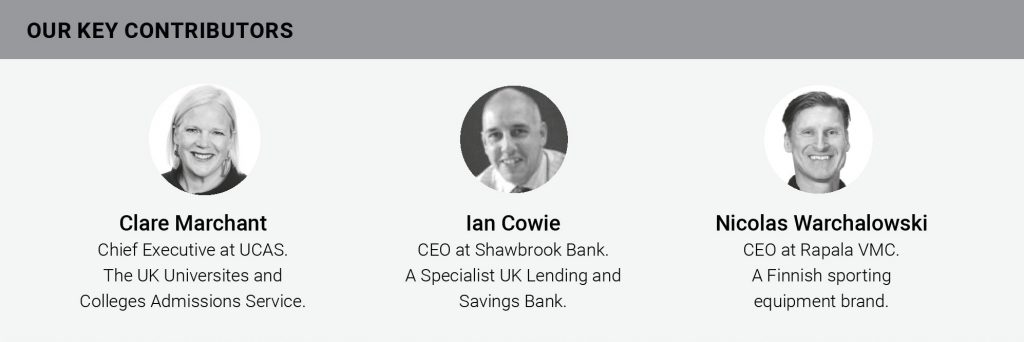
It’s fair to say that COVID-19 wasn’t the first crisis to test executive teams (and it won’t be the last). But this pandemic has proven that change can happen overnight and how quickly teams can align.
There will always be external pressures that make executives feel like their jobs are at times impossible. In fact, senior leaders in our survey revealed that their biggest challenge right now is having decision-making restricted by silos.
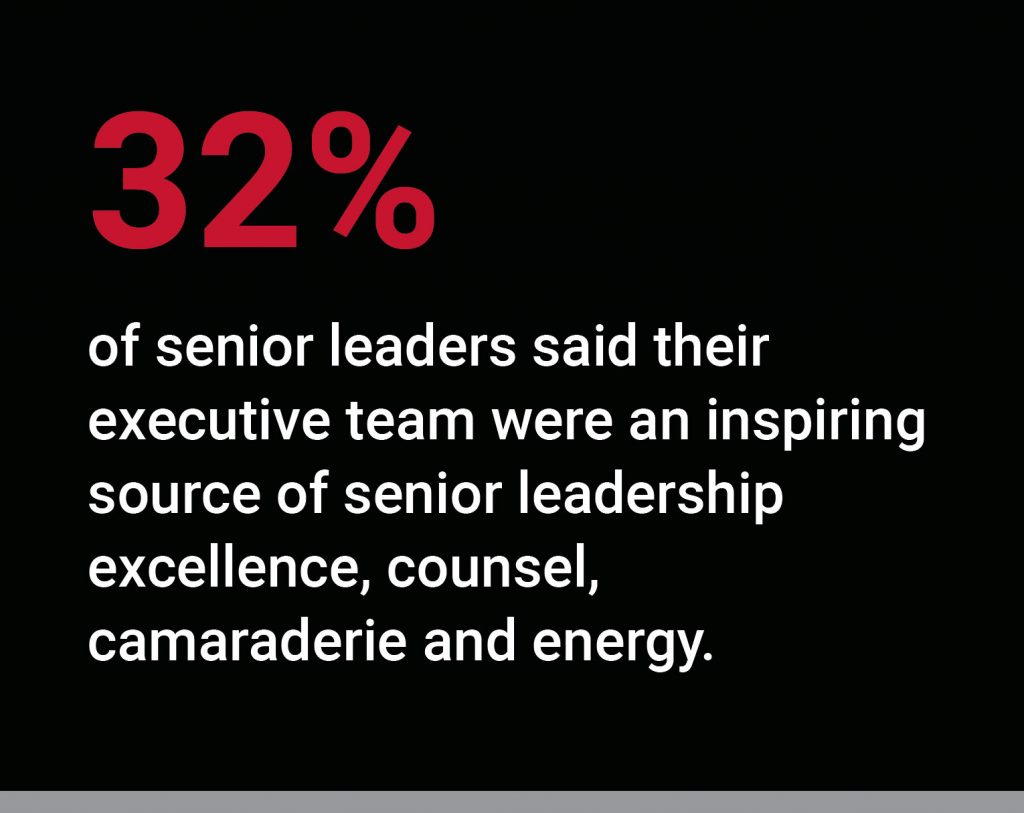
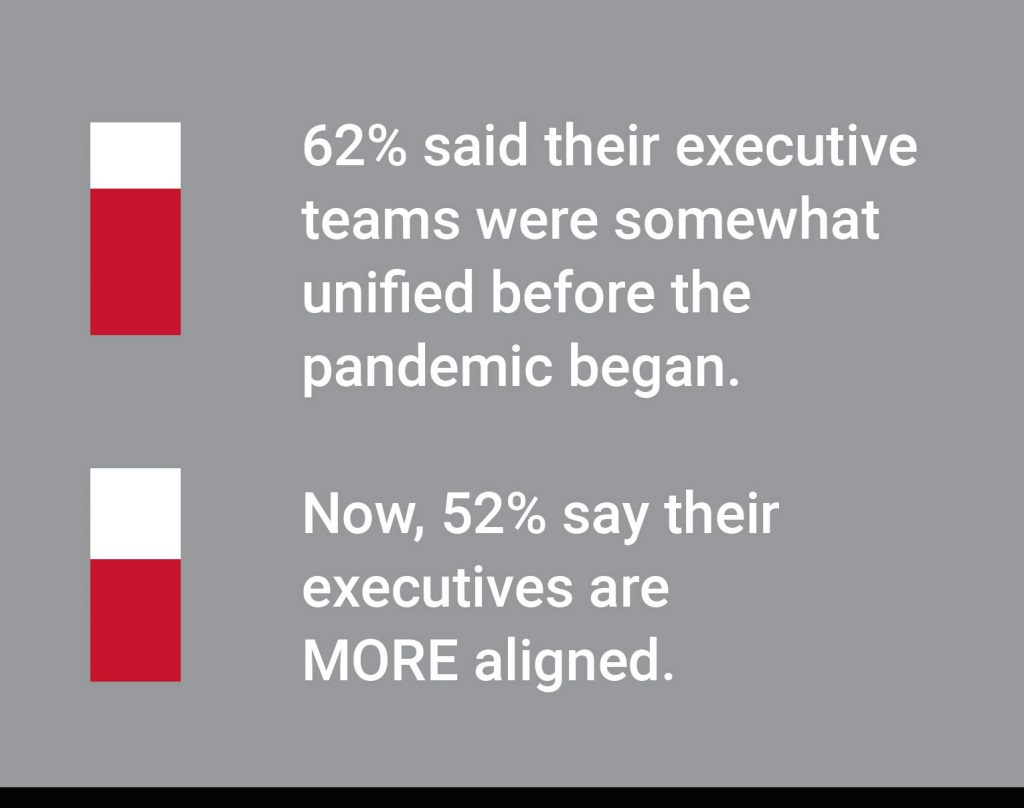
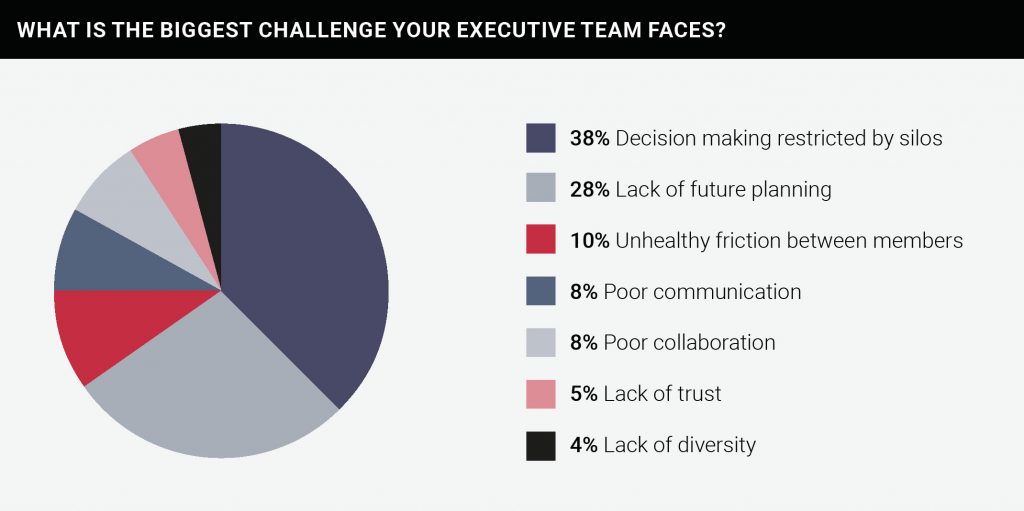
But organisations have already implemented large-scale changes in the past year that they thought were previously unattainable – so what excuse do you have now for not being able to improve the way your SLT functions and leads?
Our advice: sustain the momentum of change. Acknowledge which leadership competencies and characteristics need developing. Take this time of regrowth to evaluate the performance of your executive team, and put in place processes that’ll give you a strong foundation for the future.

“Coming out of the crisis you have to encourage people to be critical; let’s not just do what makes sense in a few months, but let’s start thinking about the long term.”
Nicolas Warchalowski, CEO at Rapala VMC
As we can see from the graph, these steps are vital. Whilst it’s highly encouraging to see how confident executives are in their ability to be customer-focused and growth-minded, it’s concerning to see digital savvy and talent scout ranked as executives’ weakest leadership competencies.
These are critical for creating not only high-performing SLTs, but for long-term organisational success.
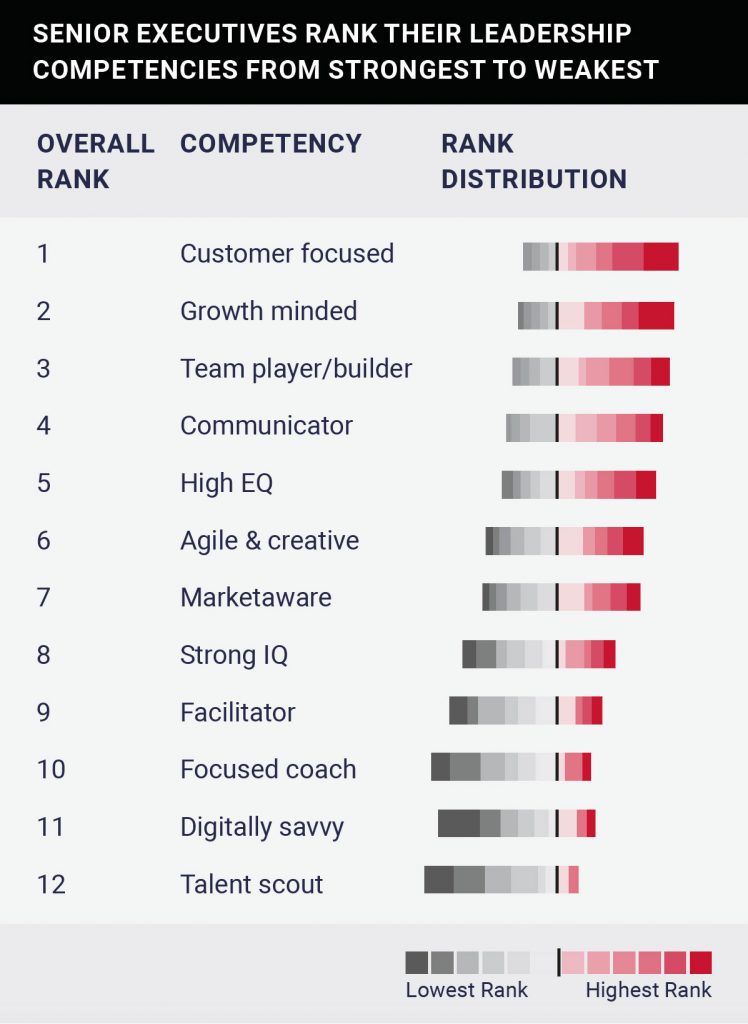
It’s time to take the first step towards strengthening your SLT and familiarise yourself with the 5 principles of high-performing executive teams.
As a team, you use language like ‘WE’ before ‘I’ and put ‘SLT’ before ‘function’.
Individuals actively listen, ask questions and show understanding of their peers.
Egos are left at the door – executives give and accept criticism in good faith.
You are high on challenge with your peers in private, and high on support in public.
Executives display commitment to build the best possible team of direct reports.
The second step? Unifying the executive team…

Get out of the way of your own ego. This is a team game
It all starts with the foundations. At the core of a successful executive team is unity, alignment and trust – a team that thinks and speaks about the organisations as a whole. We call this Collectivism, the first of our five principles. But what’s preventing executives from working as a collective?
Too often, senior leaders believe that their individual technical competence will suffice and that as long as they excel in their swim lane, all will be well. Whilst functional leadership is undoubtedly an essential requirement for each SLT member, the truth is it has little or nothing to do with how effective executives work as a body.
An individualistic approach to executive leadership brings with it silos, unhealthy friction and dysfunction. To fix the problem, you need to learn from progressive senior leaders who recognise the duality of their responsibility and invest highly in establishing close bonds with team colleagues. This begins by acknowledging there’s room for improvement.
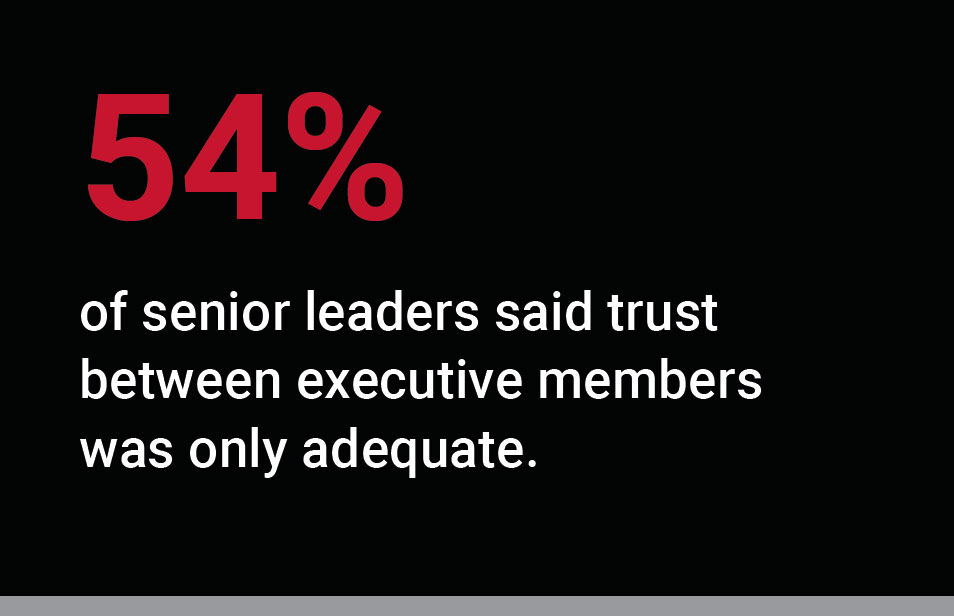

“You need to get the right balance between the horizontal and vertical; you need to be interested in the overall success of the business as well as your own vertical.”
Clare Marchant, Chief Executive at UCAS
Every executive has done enough personality matrixes in the past to know that everyone works differently, and how to caveat that. But these tests aren’t a substitute for actually getting to know the people in your team on a personal level. Often, executive teams are made up of sub-tribes of senior leaders who know each other well – and whilst these relationships may prove fruitful for those in the tribe, it often isolates and polarises others.
Investing time to getting to know different members of the team is key to strengthening communication and productivity. But remember, your attempts to build these relationships have to go beyond ice-breakers and small talk. For it to work, your interest in what other executives have to say must be authentic.
So, how do you fix this? Well, the quickest way to see if your team is working as a collective is by asking yourself:
Does your team use language associated with the collective: we, us, our? Or are they each still speaking as I, me, mine?
Your vocabulary, body language and tone play a huge part in the cohesiveness of executive teams. Getting into the habit of saying “we” and “us” might sound insignificant in the grand scheme of things, but this micro-habit reinforces group cohesion and triggers your brain into making decisions that go beyond your own function or personal interest.
Putting your pride to one side and accepting that there are things you can learn from other executives, and that what might work for you isn’t always going to be right for the wider organisation, is a big step towards creating a more unified SLT. After all, working alone only takes you so far.
First things first, as an executive team you are all jointly and severally responsible for the success of the business. That means when push comes to shove, you and your SLT are in it together until the end – whether you like it or not.
When you look at it like that, there’s no space for you to act as a lone wolf or treat other executive team members like adversaries. Because when you do, it impacts the SLT, your direct reports and the organisation as a whole.
Executive team meetings are too often like a series of one-to-ones with spectators. This approach to “team meetings” not only wastes time, but can drag performance and cultivate unnecessary friction.
Enter the CEO.
CEOs are key to facilitating the “We before I” mindset. By creating an open, safe space during SLT meetings and by encouraging bilateral communication between executives, CEOs can help democratise decision-making. This requires a “first among equals” mindset, one that allows them to facilitate debate and manage friction between executives without bias or total sovereignty (until it’s needed).
But remember, this isn’t an opportunity for you to pass the blame onto the CEO if you sit under poor leadership. Executives are more than capable of taking control and facilitating high-functioning team meetings by using the strategies above.
As cliché as it sounds, it’s still undeniably true. Strong communication is the backbone of an effective executive team. That means asking the right questions and actively listening to your peers’ responses, which brings us onto principle number two.
Too often, dissonance or misunderstandings between SLT members stem from poor communication. Senior leaders can be either too vocal or not vocal enough when engaging with their colleagues and of course, neither end of that spectrum is helpful.
Open communication and transparency around the executive table will help create a culture that builds progressive, positive, and trusting relationships between team members. It doesn’t mean that disagreements or friction won’t exist, but it’ll help you manage those conversations more productively.
Like anything, communication is a skill developed over time. It takes active participation and self-awareness from both the team and the individual. You’ll need to work at navigating different personalities and building upon different character strengths.

Here’s how Matt Crabtree, Managing Partner at Positive Momentum, helps executives turn team meetings into proper discussions:
“A radical solution I use to help executives who feel like they’re not being heard – or who aren’t listening to others – is getting each executive to shadow a counterpart for a full day so they can see the world through their eyes. In a case where this was used in a fast-moving consumer goods company, after initial resistance, the conversations that followed were found to be so effective that the method was made permanent.”
So, what does “asking the right questions” and “active listening” actually look like?
In the real world, they’re questions intended to delve deeper and strengthen understanding. They’re not questions designed to undermine or provoke, but to diversify perspectives and hold people accountable. Think about it like this: you’re discussing to understand, not arguing to win.
Active listening is all about creating a space where you are immersed in the conversation and can reflect on its meaning. For example, it’s not thinking about what your response will be whilst the other exec is still talking, or allowing yourself to be dis-tracted by Microsoft Teams notifications. It’s about seeing the world through your peer’s eyes. Actively engaging with responses is vital for you to fulfil your organisational responsibility.
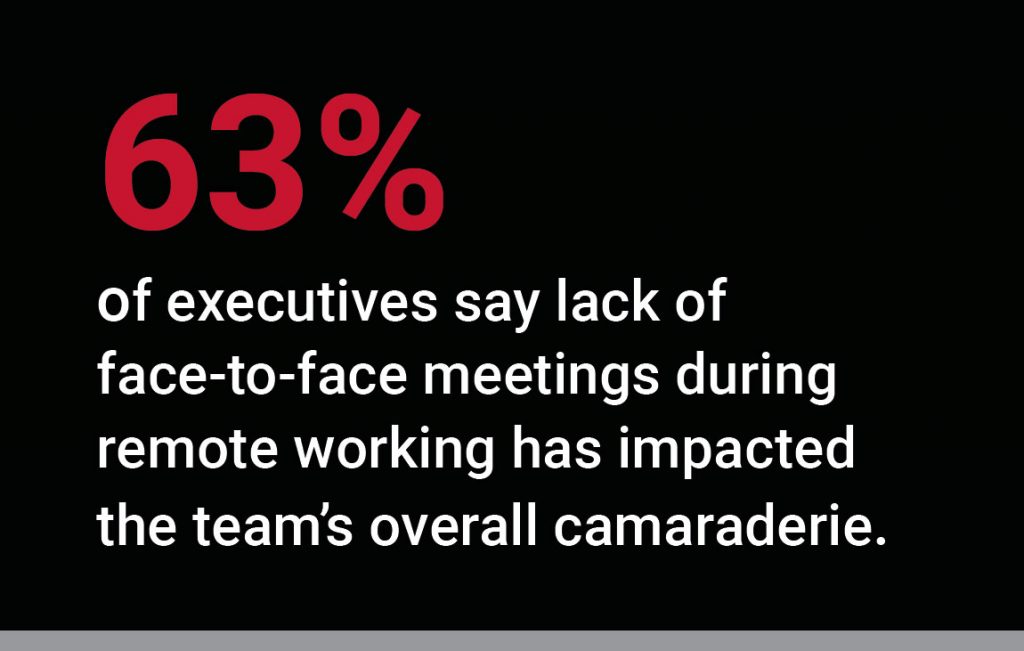

“Having quality conversations where you ask probing questions like ‘are you sure you’ve got that right?’, and ‘what would you have done differently?’ are really important”
Clare Marchant, Chief Executive at UCAS
This year has forced executives and CEOs to lead through technology. Gauging reactions through body language has become harder via screens, and being able to take someone aside for a quiet chat or informal coffee is becoming less frequent. These new challenges require attention.
If energy and camaraderie has been lost through digital communication, it’s up to the executive team to lead by example and fix it.


As Nicolas Warchalowski, CEO
at Rapala explains.
“Culture eats strategy for breakfast. The management team represents the culture.”

Blog Post:
Trust is the most valuable commodity for an executive team: it makes or breaks effectiveness. To help senior leaders develop and strengthen the trust between team members, it’s vital that executives are able to demonstrate both confidence and vulnerability in front of each other.
That doesn’t mean you need to expose your deepest secrets to your peers or stop being an outwardly confident, calm and reassuring leader to your team. What it means is that you need to hang your ‘cloak of invulnerability’ on the door before you enter an executive meeting.
After all, these people are your sisters and brothers in arms, your organisational family. Yes, you’ll fight and disagree at times in private, but you’re also there to support and champion each other both in private but more importantly in public. This is not the place to have shields up; leave your ego at the door.
The COVID-19 pandemic has helped many senior leaders become more compassionate and understanding of their employees’ needs. But despite this, only 5% of senior leaders said that all of the executives within their team demonstrate openness and vulnerability toward each other. For this to improve, it’s vital that vulnerability and openness are NOT viewed as a weakness by senior leaders. The inability to seek truth is what poisons productivity and breaks apart teams.
On the flip side, executives need to be prepared to constructively challenge one another. A core part of principle 3 is being able to give, and importantly, accept criticism in good faith knowing that its purpose is to benefit the health and performance of your organisation. Taking accountability for your actions is just as important in building trust as being able to deliver constructive criticism.
For SLTs to be able to do this effectively, they need to be able to be open and honest with each other. That’s why it’s critical that CEOs take an active role in facilitating a safe and impartial space for executive teams to have these conversations in.

“CEOs have to be able to create that sort of landscape – that environment where people have the confidence to say what they really feel. That in itself, you know, takes some time.”
Clare Marchant, Chief Executive at UCAS
Like any machine, friction is a critical force. Too little and everything slips, but too much, and everything gets jammed up.
When managed appropriately, friction can be a catalyst for change within executive teams. Just like cogs in a machine, senior leaders need to positively challenge each other: too little and they’ll lose their competitive edge, but too much can cause irreparable damage. Finding the right balance is a delicate task.
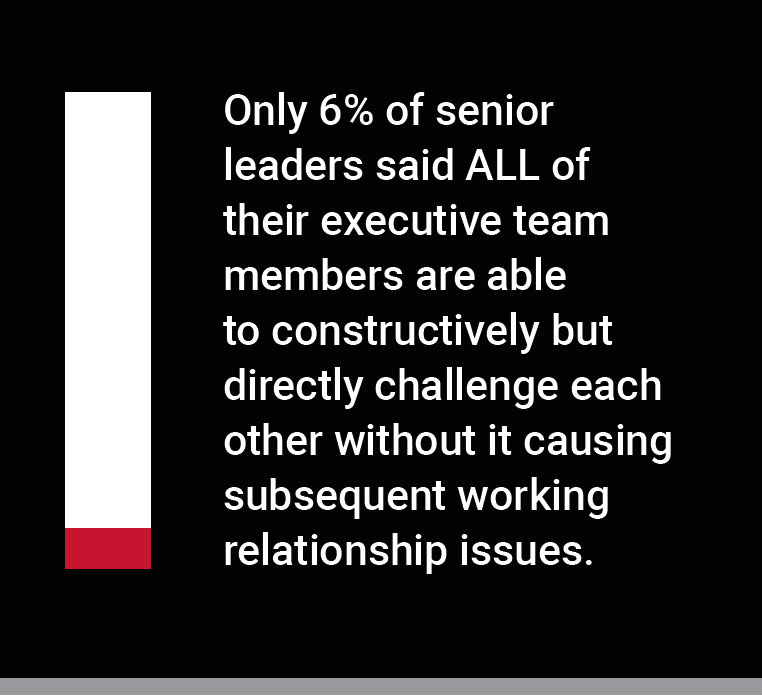
This is because in many SLTs, drama is fuelled when executives bad-mouth each other to their respective teams – exacerbating tension and exaggerating challenges.
Whilst disagreement and tension is an inevitable side effect of a high-pressure environment, there is a solution. Critical friendship.

This happens far too often, as Matt Crabtree, Managing Partner of Positive Momentum explains:
“I saw this in the multi-national executive team of a global B2B business. They weren’t telling each other what they thought they should do differently, but they were busy telling their team members exactly what they thought of their peers and it was none too complimentary. This lack of courage and discretion was fast killing the culture and performance was declining precipitously.”

Be highly supportive and highly challenging of your peers: the two core principles of critical friendships. In other words, in private you must be able to (when appropriate) challenge decisions and offer constructive support. In public, the executive team must be completely cohesive and defensive of each other. This open and supportive approach helps SLTs strengthen cross-functional confidence, and demonstrates to the wider organisation that the SLT are a unified and aligned body.

“I’m a great believer in 360- degree reviews. If I think there’s a leadership or
style issue, I’ll set it as a performance objective for my executive and ask for feedback from their peers. If they meet it, they’ll receive their bonus. Using qualitative feedback in a quantitative way is really important.”
Clare Marchant, Chief Executive at UCAS
Whilst critical friendships are something that executives must continually develop as individuals over time, CEOs can help to nurture this process by constructively supporting executives through performance reviews. Some executives, whether we like it or not, will be reluctant to change. But fear not. We’ve helped teach our fair share of old dogs some new tricks.
In the spirit of unity and teamwork, ‘grandparent reviews’ (setting the executive an objective and seeing how it impacts the team one layer down) are a highly effective way of motivating individuals and holding them accountable for their actions. By regularly reviewing progress against specific deliverables, and by asking people beneath and above your executive to review their performance, CEOs can determine whether the executive is worthy of, say, a bonus. And for organisations as a whole, external critical reviews of executive teams can bring new perspectives and solutions to fractured SLTs.

“Healthy friction takes some time, it needs to come from the group, from within. That’s why diversity and recruiting people with the right value set is very important.
Nicolas Warchalowski, CEO at Rapala
Relationships will disintegrate if you always defend your team and their performance no matter what.
As an executive, you need to be relentless in your desire to set higher standards for your organisation to enhance its performance and output. That means actively strengthening the unity and alignment of the SLT, as well as taking responsibility for your team of direct reports.
One of the quickest ways to break trust with fellow executives is to blindly defend the performance of your function when you know there’s room for improvement – and let’s be real, there is always room for improvement. Whilst it might be human nature to meet criticism of your team with defensiveness, these open (albeit difficult) conversations are fundamental to raising standards for your organisation. It’s also worth remembering here that this is what being a collective team is all about – your joint responsibility to make sure standards across the executive team and in the next layer down improve all the time. It’s this self-regulation that will help you thrive, even through a crisis.

Here’s how Rajnish Virmani, Managing Partner at PositiveMomentum India, dealt with a similar situation.
“Every month for six months, I suggested the executive team take a collective approach to considering whether each of the leaders in the next layer down to them made them feel confident, concerned, or if they felt they needed extra support. This repeated, progressive and collaborative approach resulted in a 90% reduction of leaders on the concerned list by the end of the six month period. Better still, projects that had been mired in delay and distraction were powering forward.”
Part of setting a higher standard is ensuring the quality of your executive (and reporting) team is as strong as it can be. Actively seeking and developing talent as a collective is key – whether you’re nurturing existing employees for future executive roles or building network pools with external talent. Concerningly, ‘talent scout’ was ranked by our executives as the competency they most needed to develop.
The reason why this skill is so important is because you’re going to want a senior leadership team that’s mutually confident in each other’s ability and that actively endorses each other (and their strategies) in public. This energy will manifest itself into a consistent and energised culture that even the cynics can’t challenge.


“The best executive teams empower, inspire and bring on the best people around them – they’re not threatened by that. “
Clare Marchant, Chief Executive at UCAS
When it comes to raising the bar, it’s vital that senior leaders take responsibility for the diversity of their team. Executive teams need to be visibly and actively engaging with different perspectives, experiences and backgrounds, whether that insight comes from other senior leaders or from employees further down the ranks. It’ll not only help bring in fresh ideas and new ways of working, but executive teams’ full appreciation and respect for diversity will help your organisation become a destination employer for the best talent.
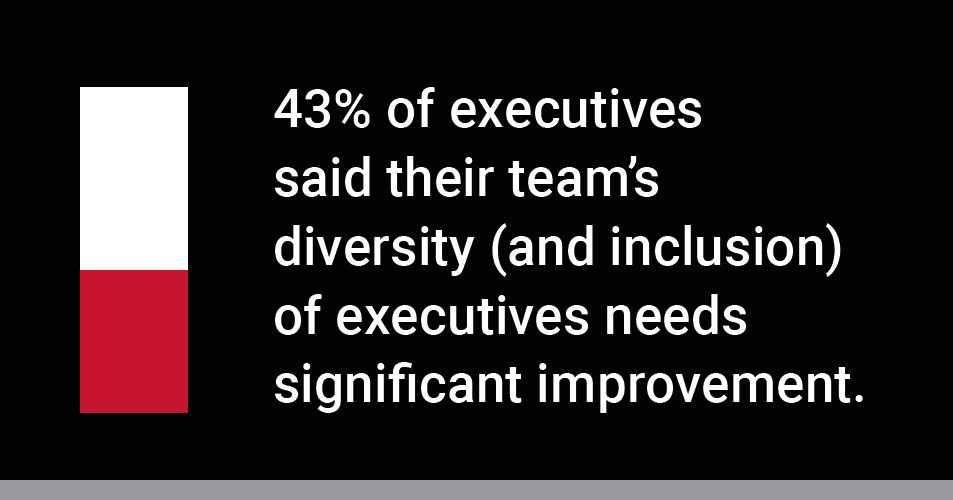

“Diversity – having different backgrounds and personalities are attributes that make an effective executive team.”
Nicolas Warchalowski, CEO at Rapala VMC
Section 7:

There it is. 20 years of experience working with senior leaders and CEOs compiled neatly into 5 high-performing principles for you to utilise.
If all those years and past crises have taught us anything, it’s that a strong foundation and agile team can get you through the unthinkable. These principles are more than just consultative ideals – they’re real-world practical strategies that can help organisations withstand volatility, catapult performance and facilitate even the most ambitious future-planning strategies. Right now, you have an opportunity to lead and strengthen your executive team by turning these principles into a reality. Don’t let the opportunity go to waste.
Download PDF
The three things executives should have: 1. The desire to change the business for the better, 2. The ability to inspire and lead with authenticity, 3. The interest in the business being successful corporately but accountable for what you’re held responsible for.
Clare Marchant,
Chief Executive at UCAS
Each of our consulting partners has deep client-side experience in one or more of our key areas of specialism